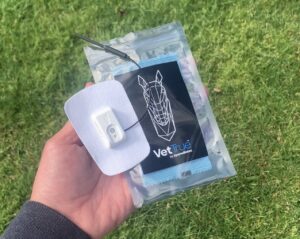High-Tech Temperature Monitoring in the Management of Infectious Disease Outbreaks
By Dr. Michael Hurley | Posted on October 20, 2021

In a worldwide first, the VetTrue™ System from Epona Biotec has been successfully used in the management of an equine infectious disease outbreak.
A pregnant mare on a Thoroughbred stud farm developed the neurological form of Equine Herpes Virus (EHV-1). The mare was immediately isolated, but rapidly deterioration over several days, and was euthanised on humane grounds.
EHV-1 is a highly contagious virus and easily spread by direct horse-to-horse contact or by indirect contact with contaminated objects. The stud farm immediately instigated biosecurity measures to contain the spread of the disease. These included segregation of staff and horses, and the mandatory use of PPE by all staff members.

Temperature monitoring during disease outbreaks is important for identifying other infected individuals.
In a novel approach by the stud farm, three stallions and seventeen close contact mares had their temperatures remotely monitored using the VetTrue™ System.
As the incubation period for EHV-1 is very short, further cases would be expected in the week following the first case if the disease were spreading on the farm. A fever is usually the first clinical sign seen with this viral infection, so by screening temperatures closely with the VetTrue™ System the farm could easily identify other infected horses and further isolate and treat them.
Normal temperature charts from four of the horses monitored on the farm




After monitoring the horses for seven days, no fevers were identified and no further horses became ill with EHV-1. The VetTrue™ System gave staff additional assurance in the early days following the first clinical case that the disease was not spreading on the farm.
Fortunately, this was a single isolated case of EHV-1, with the virus most likely contained from spread by the strict biosecurity measures immediately implemented by the farm.
The VetTrue™ System proved time-saving by avoiding the need to take rectal temperatures twice daily, as well as providing a complete record of temperatures for each horse during the monitoring period. Remote monitoring was also of benefit in reducing contact with horses, potentially limiting opportunities for disease transmission and improving biosecurity.
This is the first known report of a remote temperature monitoring system being used in the face of a potential disease outbreak.
Related Posts
Elite Thoroughbred Racehorses: The Impact of Shipping Fever on Performance
Posted on May 26, 2021
In 2016 some fascinating research was presented at the 21st International Conference of Racing Analysts and Veterinarians (ICRAV) in Montevideo, Uruguay. Titled “The incidence of shipping fever and the impact on performance in horses travelling to compete in the Hong Kong International Races (2005-2014)”, the research looked at the race results of 282 elite horses imported to race during this ten year period. Of these horses, 33 (11.7%) had developed a fever during the flight to Hong Kong and had displayed mild to moderate clinical signs of shipping fever. Four of these horses were so sick they were withdrawn from racing, but the other 29 went on to compete in the Group 1 races. Of these horses, none won a race and two-thirds of them finished in 10th place or worse. What this study clearly showed is at the elite level of equine sports competition, everything about the horse needs to be 100% for them to compete to the best of their ability. Even a transient temperature, and mild clinical signs in the week before competition, is enough to affect the performance of a horse. In retrospect, and armed with this knowledge, the connections of these horses would likely have been inclined to withdraw them from racing, especially if a poor result might have impacted future breeding or stud value. Horse Trainers worldwide can incorporate this knowledge into their training preparation to ensure horses reach competition day in peak condition. Whether you are a Thoroughbred, Quarter horse, Arabian, Standardbred or Cross Country trainer, monitoring your horse’s temperature with the VetTrue™ System during travel to, and in the 48 hours before competition, will give you additional confidence the horse has no subtle underlying respiratory condition and can compete to the best of its ability. The VetTrue™ System will provide a complete 24 hour temperature record, and transient fevers will no longer be missed. Give your stable the edge and improve performance results. Contact Epona Biotec today for further information. www.eponabiotec.com #vettrue #eponabiotec #icrav #shippingfever #hkir #hkjc #horsewelfare #horseperformance #itsallaboutthehorse
Improving Biosecurity at Equestrian Events: The VetTrue™ System
Posted on June 21, 2021
Biosecurity at Equestrian events is of critical importance. Large numbers of horses arriving from far and wide to one location creates the potential for the rapid spread of any introduced infectious disease. Accurately monitoring the temperatures of horses before they arrive is therefore crucial. This is because the one clinical sign all equine infectious diseases have in common is a fever. Real-time, 24 hour temperature monitoring, before entry to an equestrian event is far more accurate at detecting fevers than twice daily rectal temperature readings. Take a look at this video demonstrating use of the VetTrue™ System before entry to an equestrian show jumping competition. Simple to use and extremely cost-effective. #eponabiotec #vettrue #equinebiosecurity #equineinfectiousdisease #equineherpesvirus #strangles #equineinfluenza #shippingfever #horsetemperature #horsemonitoring #itsallaboutthehorse https://youtu.be/8kGUvWeqeFc
Measuring Body Temperature in Horses
Posted on September 29, 2021
Very informative article on body temperature in horses by Kentucky Equine Research. The research discusses using the VetTrue™ System from Epona Biotec to accurately record body temperatures during the study.Link to Article#eponabiotec #vettrue #equine #horse #equestrian #research#horsemonitoring #horsehealth #itsallaboutthehorse
My Horse Has a Fever: Now What?
Posted on October 6, 2021
A very informative article about managing horses with fevers by Dr Elizabeth MacDonald for the United States Eventing Association (USEA). The VetTrue™ System is a great way of monitoring your horse closely once a fever has been detected. Contact us to learn more here.#eponabiotec #vettrue #horse #equestrian #pony #vet #equinebiosecurity #equineinfectiousdisease #strangles #equineinfluenza #shippingfever #horsetemperature #horsemonitoring #fever #usef #itsallaboutthehorse